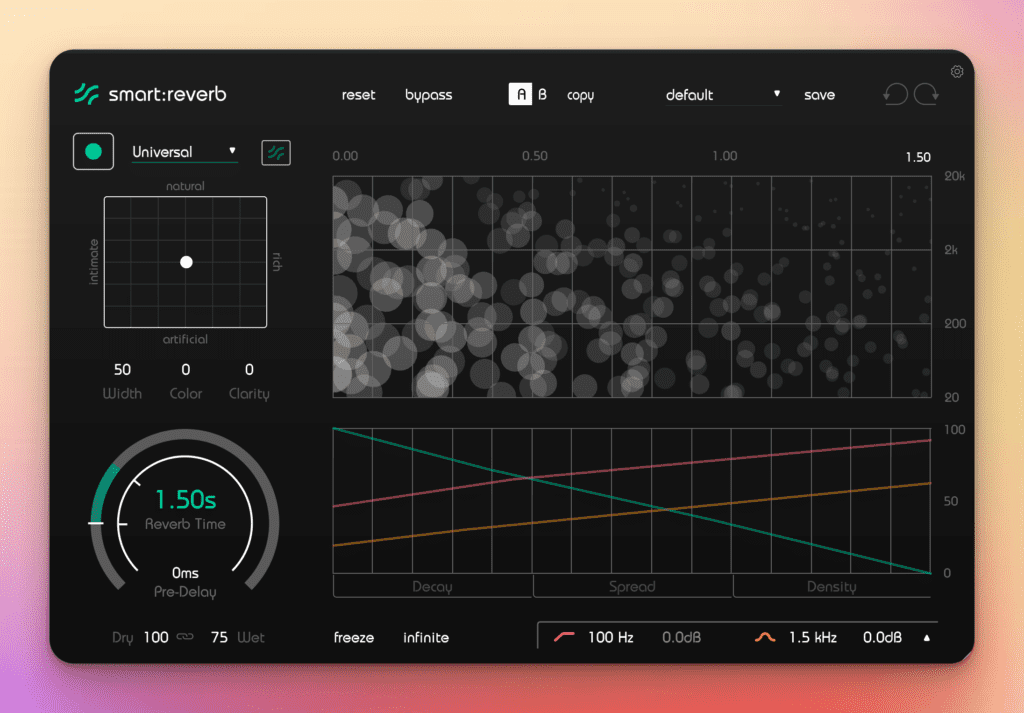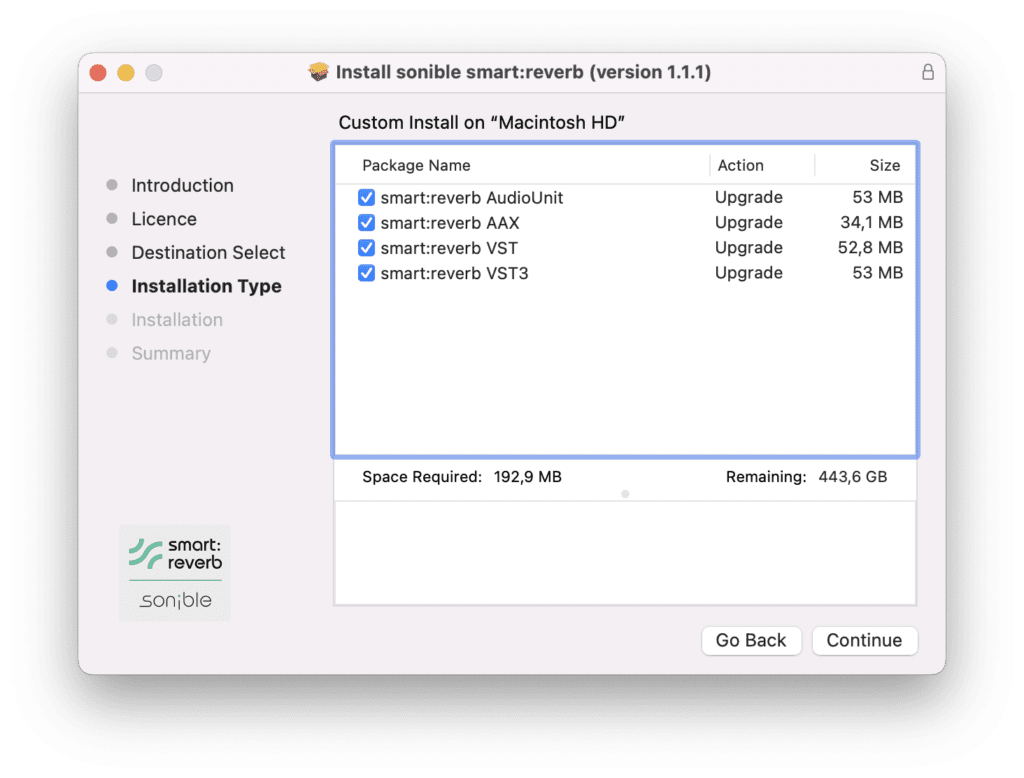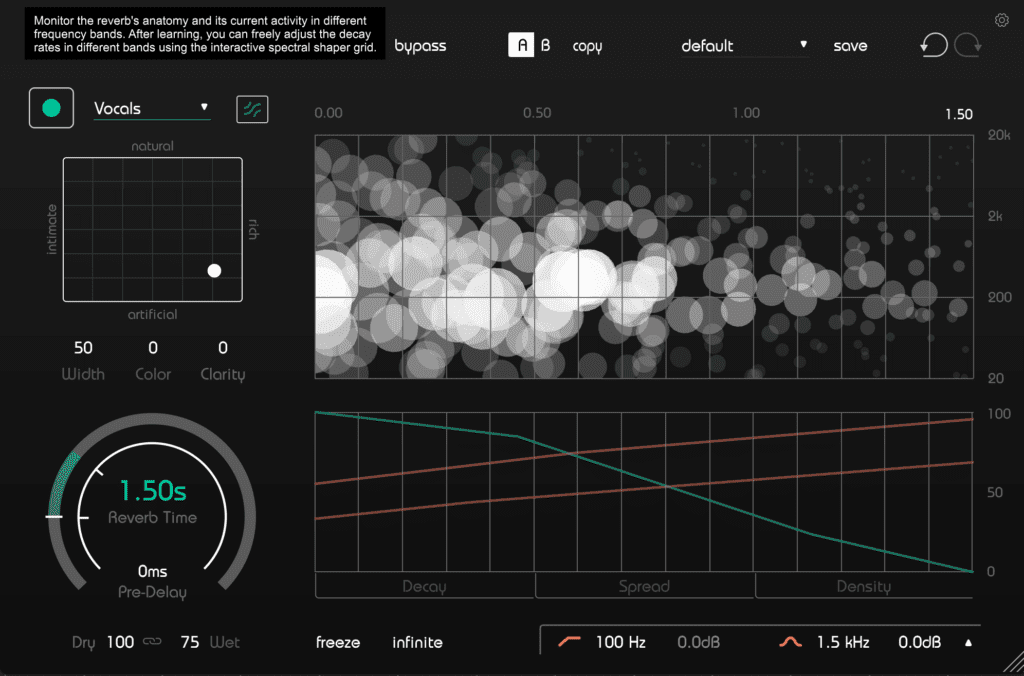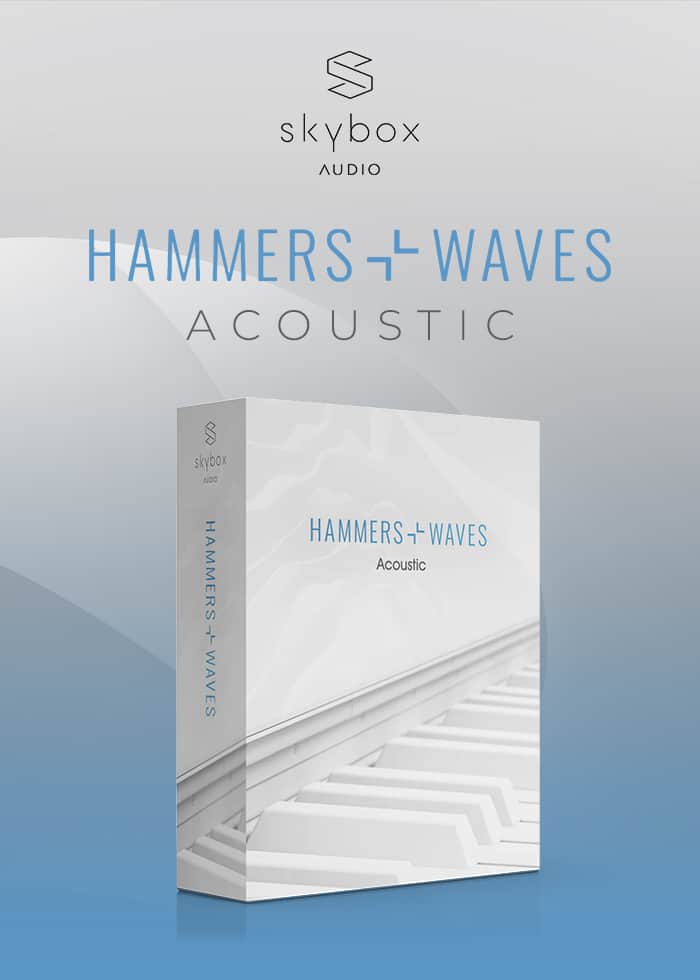Reverb is one of the essential tools in a producer or engineer’s toolkit. It can make a track sound bigger, add space to a mix, and even create entire sonic landscapes. However, traditional reverbs can often be challenging to control, and they can often introduce unwanted artifacts into the signal.
Sonible’s new plugin, smart:reverb, solves these problems by creating custom reverbs from scratch. With just one click, smart:reverb analyzes the source material quickly to create every reverb from scratch. By custom-fitting, the reverb to the spectral and temporal characteristics of the input signal, typical problems such as disturbing resonances or muddy reverb tails are avoided from the beginning.

smart:reverb
Are you looking for the perfect reverb to add that extra something to your music? Look no further than smart:reverb, the custom-tailored reverb that does it all. Just a few seconds is all it takes to get the perfect sound with our easy-to-use matrix. Choose from a broad spectrum of styles, then adjust the time and frequency settings to get exactly the sound you’re looking for.
And with our signal-adaptive controls, you can quickly dial in the perfect amount of width, color, and clarity. Plus, our pre-filter EQ lets you easily shape the signal before it hits the reverb so that you can get the right sound. And for those times when you want something extra special, our Infinite, and Freeze features are perfect for layering sounds and creating new textures.

smart:reverb Tailored Reverb
Your perfect reverb, sound and mood–instantly. One of the great things about smart:reverb is that it offers a wide spectrum of different styles. Whether you need a lush reverb for a ballad, or a gritty reverb for a rock song, smart:reverb can do it all. And because it’s tailored to the specific characteristics of the input signal, you don’t have to worry about unwanted artifacts or muddy reverbs.
If you’re looking for one-size-fits-all reverb plugins, you might want to give smart:reverb a miss. But this is the plugin for you if you’re after something that will deliver a custom-tailored sound. By adjusting its processing to the individual characteristics of the input material, smart:reverb creates a navigable range of styles from scratch.
So whether you’re after a lush room sound or a tight and focused SRV tone, smart:reverb has got you covered. Just don’t expect it to do your laundry as well.
Probe Traits, Not Presets
There are so many types of reverb out there – artificial, intimate, natural, and everything in between. But which one is right for you? Smart:reverb makes things easier by creating reverb based on the source signal rather than presets or pre-recorded impulse responses.
With its handy reverb matrix, you can browse through all the possibilities until you find the perfect fit for your input signal. So go ahead and explore – smart:reverb will guide you to the right reverb style, every time.
Deep in the heart of the smart:reverb lies a detailed and interactive view of the reverb’s anatomy. By manipulating the deep structure of the reverb, you can control its frequency, time-dependent decay rate, and even its spread or density over time. With this level of control, you can easily create the perfect reverberation for your needs. So go ahead and explore the depths of the smart:reverb today. You may be surprised at what you find lurking within.

Reverb Powered by A.I.
Reverb is essential to any audio production, but it can be challenging to get just right. Smart:reverb is a new tool that uses artificial intelligence to create custom-fitted reverbs for any signal quickly. By analyzing the source material and custom-fitting the reverb to its spectral and temporal characteristics, smart:reverb avoids common problems such as muddy tails or disturbing resonances.
With just one click, you can create a reverb that sounds natural and fits your signal perfectly. Whether mixing a song or working on sound design for a film, smart:reverb is the perfect tool for getting the best possible sound.
Smart:Reverb: The Engine
As with all Sonible plugins, Smart:Reverb has a beautiful, modern interface with a clean, easy-to-understand design. You have a drop-down option in the top left for various input signal types, such as universal, vocals, guitar, and even speech. Various controls change and shift to match the input type when you select an input type.
For example, selecting ‘vocal’ will enable a modulation dial that wouldn’t be relevant for other signal types. It’s worth noting that changing the input type doesn’t affect the reverb time, pre-delay, dry/wet values, and a few other vital parameters, which makes sense as these values are highly dependent on the reverb style you’re going for. That said, it’s still a convenient feature as it streamlines the process of finding the perfect set of parameters for your vocal track.
The beauty of this grid is that it allows you to change the character and tonality of your sound with just a few clicks. Depending on your needs, you can make your sound more natural, intimate, or artificial. The best part is that you can change the setting at any time, so you can always find the perfect balance for your song. The only downside is that it can be a bit overwhelming at first, but once you get the hang of it, you’ll be able to create some wonderful sounds.

Smart:Reverb Possibilities
The first thing that struck me about Smart:Reverb was the sheer range of possibilities offered by the plugin. Not only can you create standard reverbs, but you can also use the spectral shaper to create all sorts of bizarre and beautiful sounds. The temporal shaper is also great for adding ethereal effects or making the reverb tail decay in exciting ways. In short, this plugin is a veritable playground for sound designers.
The second thing that impressed me about Smart:Reverb was the sound quality. Even with all the bells and whistles, the plugin never sounds muddy or overblown. The reverbs are always transparent and intelligible, and the plugin does an excellent job of preserving the original tone of your instrument or voice. Overall, I was very impressed with Smart:Reverb and highly recommend it to anyone looking for a high-quality reverb plugin.

UX and User Interface
Reverb is an essential tool for any musician or sound engineer, but it can also be one of the most challenging effects to get right. With smart:reverb, you can quickly and easily find the perfect reverb effect for your needs. The intuitive interface and descriptive properties make it easy to find the style of reverb you’re looking for. At the same time, the extensive control options allow you to fine-tune the sound to get precisely the desired effect. Whether you’re looking for a simple room ambiance or a complex multi-EQ effect, smart:reverb has you covered.
sonible GmbH designed the interface of smart:reverb with users in mind. With helpful visual representations and a generally lean interface, smart:reverb is an efficient and informative tool for audio production.
While many companies are vying for attention with ever-more complex A.I. features, sonible has taken a different tack with its new plug-in. Rather than adding yet another layer of automation, the company has focused on giving users more control over the sound of their recordings. The result is a plug-in that is both easy to use and highly versatile. At its core, the plug-in features a simple EQ interface that can be used to shape the sound of recorded vocals and instruments.
But where it shines is in its ability to adapt to the user’s needs. For example, if you want to add more depth to a recording, the plug-in can automatically adjust the EQ to compensate. Similarly, if you want to reduce background noise, the plug-in can apply a noise reduction algorithm tailored to your specific recording. In short, the sonible plug-in is an excellent example of how A.I. can be used to empower users rather than replace them.
The Particle Display with its Spectral Shaper Grid and the Temporal Shaper – where you can shape the temporal behavior of decay, spread, and density – gives you much freedom to shape your reverb effect. And if that’s not enough control for you, sonible also included a traditional EQ section so you can hone in on those perfect soundscapes. So whether you’re looking for a little ambiance or a complete sonic overhaul, smart:reverb has you covered.
The starting points of using the automatic features are amazing, but if you’re like me and you like to tweak, this intuitive plug-in will inspire you! The best part is that it doesn’t sound artificial at all; it sounds pretty natural. I highly recommend giving smart:reverb a try. You just might be surprised at how much you like it!
About sonible GmbH
From mixing engineers, FOH engineers, and music producers to AI experts, software developers, DJs, and musicians – the sonible team is an eclectic mix of highly skilled engineers and creative individuals. sonible put their vast audio experience and user-oriented focus into developing AI-assisted audio plug-ins, designing and implementing 3D audio systems, and building audio hardware – sound in all its complexity is sonible’s passion.
sonible transforms technological possibilities into audio production tools characterized by their incredible sound, intuitive usability, and workflow-enhancing features – in short, tools that inspire creativity.
Conclusion
It’s a common dilemma: you’re looking for the perfect reverb, but you don’t want to spend hours sifting through hundreds of presets. Enter smart:reverb, the plug-in that makes finding the right reverb a breeze. Simultaneously, smart:reverb computes a matrix that provides a range of styles for the reverb at hand—each of them tailored to the input signal.
Guided by descriptive properties, users can quickly find the style best suits their creative visions. And for maximum control, the plug-in provides an interactive view of the reverb’s anatomy. A detailed interface makes it easy to manipulate the deep structure of the reverb by modifying its frequency and time-dependent decay rate as well as the reverb’s spread or density evolvement over time. With smart:reverb, getting the perfect reverb is easy—so you can get back to what you do best: making great music.
If you’re looking for a reverb plug-in that will give you custom-tailored sound, then smart:reverb is the perfect choice. It can adjust its processing to the individual characteristics of your input material, so you’ll always get the best possible sound.
In addition, the smart:reverb interface is exceptionally intuitive and easy to use. You’ll be able to quickly find the perfect sound for your tracks with its unique reverb matrix. So if you’re looking for a top-quality reverb plug-in, check out smart:reverb!










